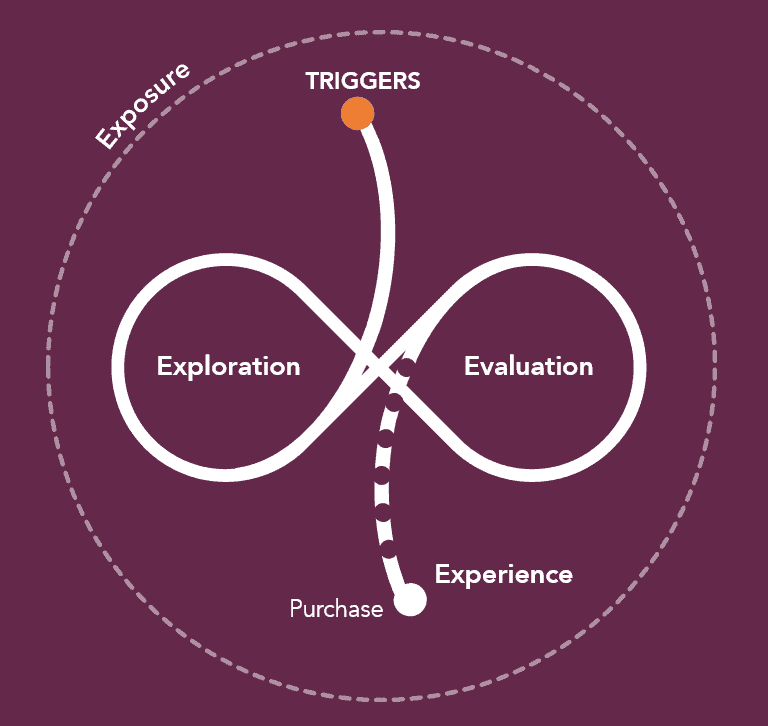If you do a Google search for how many marketing touchpoints it takes to make a sale, the results would have you believe seven or eight is the lucky number.
However, I’ve yet to meet a B2B marketing leader who’d hang their hat on such a low number.
Based on my non-scientific survey of B2B leaders who have engaged our team for marketing services for contract research organizations and healthcare software marketing of complex technology products with sales cycles upwards of nine months to two years, the answers varied widely but landed, on average, at least 4x more than what the top Google results claim.
Some even admitted they couldn’t say with certainty, but it was a lot. The truth of the matter is that it’s just not that simple.
Enter the customer journey map.
What is customer journey mapping?
At its most basic, customer journey mapping is a visual representation of the path an individual or organization takes from initial awareness through purchase and renewal.
Organizations should start with an ideal customer buying journey and revisit it annually as part of their strategic planning. It is an easy way to make sense of the ever-increasing marketing data at your fingertips.
Let’s get this out of the way, the customer buying journey isn’t the linear path we’ve been led to believe it is. It’s more like an infinite loop of exploration and evaluation with the goal of finding marketing touchpoints that lead your customers to the experience you are promising.
Sample AI prompts to kickstart your process
Surprise marketers, you can use generative AI tools for more than writing witty headlines and social media posts!
You can also use it to make sense of and identify trends in data from your marketing automation system, social media feeds, and anywhere else — the possibilities are endless.
Here are three prompts to help you get started:
Understand your customer buying journey analytics more holistically
Start by downloading the marketing activity for ten new customers whose demographics most closely align with your ideal customer profile. Upload that data into ChatGPT and ask it to summarize the activity and identify trends that led to a sale.
Some of the questions you may ask include:
- How many emails did the contact receive?
- How many website pages did the contact visit?
- How many times did a sales representative talk to the contact?
- At what point are contacts most at risk to unsubscribe?
The point is to identify what your new customers are engaging with during the buying journey and do more of it while removing those activities that they do not engage with. It can also help you streamline where you’re losing people during the long sales cycle.
Caveat: this level of analysis is only possible if your organization is tracking all marketing and sales touchpoints in a platform such as HubSpot or Salesforce.
Gauge positive and negative sentiment
It’s not uncommon for salespeople to record conversations with prospects. Returning to your ten newest customers, take the transcripts from those calls and use AI to identify the messages that most resonated with those wins.
Similarly, use the transcripts from those calls that did not convert to a sale to see if the contact raised negative associations that could have been countered with a follow-up email or other educational content.
Automate answers to the most common questions via chatbots
What better way to leverage AI than to use it to create chatbot workflows that answer your prospects’ most common questions?
In tracking emails with prospects, marketers should be able to identify the topics resonating with potential buyers and use that information to insert chatbots into the customer journey.
Your email communication and click-through data is a trove of valuable information if you know how to use it. Answering your prospects’ questions BEFORE they ask them is a great opportunity to build loyalty, and automating it saves time and resources.
Gain customer buying insights while saving valuable time
It’s easy to map out your ideal customer buying journey and leave it at that. However, a marketing leader must challenge the status quo and use data to back their recommendations.
With new AI marketing tools cropping up daily, including in your CRM, there’s no excuse not to gain new insights from the data you’re already collecting. Now, you can uncover new ideas in minutes instead of days or even weeks, crunching numbers and analyzing spreadsheets.
Start thinking bigger and make AI your data partner for more accurate B2B customer journey mapping.



